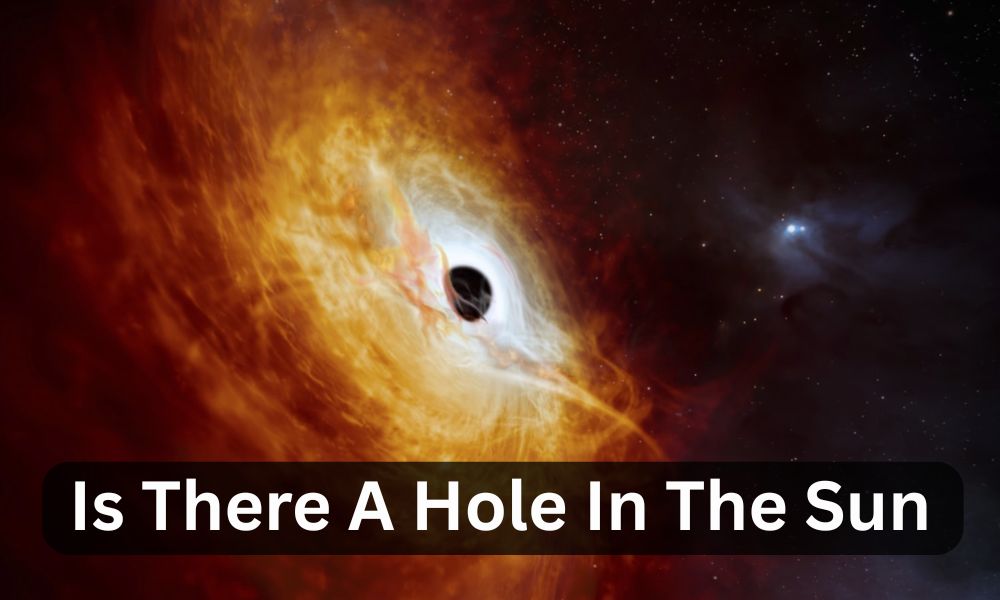Everything You Want To Know About – Is There A Hole In The Sun?
The sun looks like a massive fireball when viewed from Earth. However, you might have seen pictorial images, movies, or headlines asking, “Is There A Hole In The Sun?” You may feel that it is an alarming sign, mirroring the visions of our life-giving star, that it is about to be damaged. But, no need to be afraid! The reality is less likely to be catastrophic and quite interesting. They are actually real holes, but not empty spaces. They are actually features present in the Sun’s atmosphere, termed as Coronal Holes.
But what are these coronal holes? Are they harmful? Do they cause damage to Earth? If you have these questions in mind, let us hold on, and read further to learn everything about “Is there a hole in the Sun?
What Are Coronal Holes?
Are you thinking, is there a hole in the Sun? The simple answer is No.
During the past few days, a giant dark hole has opened up in the Sun’s outermost layer and is emitting powerful radiation called solar wind, and pointing directly towards the Earth. Coronal holes are the regions where the magnetic field of the Sun opens up, letting the Solar wind move freely into space. They appear darker in ultraviolet images since the hot, glowing gases held by magnetic fields are absent and the plasma escapes outward.
The size of this temporary hole is 62 times larger than the diameter of the Earth, and it appeared near the equator of the Sun during December 2nd, reaching a maximum width of approximately 497,000 miles, i.e., 800,000 km, within a day, causing a minor geomagnetic storm. Though these storms are not severe, they can cause intense aurora displays and also create brighter northern and southern lights at higher altitudes.
What Causes The Formation Of These Sun’s Holes Or Corona Holes?
The Sun is regarded as a giant ball of superheated plasma, an extremely hot gas, which causes splitting of atoms into positively charged ions (protons), and negatively charged ions (electrons), that are capable of moving away from each other. When these ions move rapidly, they create powerful magnetic fields, which collide with one another and move back towards the Sun. These magnetic fields play an important role in the formation of the Sun’s outermost atmosphere, known as the Corona.
Usually, the lines of the Sun’s magnetic field are bound together tightly, trapping superheated plasma and thus forming the bright and dynamic corona that we often see in pictures. But in some regions, these magnetic fields open up and move far away into space, leading to the formation of coronal holes.
Why Do Coronal Holes Appear Dark?
As the magnetic field lines open up in these zones, the hot plasma becomes free to escape into outer space in the form of solar wind, leaving behind the weaker zones with lower density and temperature of plasma with respect to the surrounding corona. The lower density and lower temperature cause less emission of light. This results in the coronal holes looking darker in extreme Ultraviolet and X-ray images of the Sun. These are not true holes with regard to voids, but are merely regions with particularly less bright but hotter plasma.
Are Coronal Holes Dangerous?
Though coronal holes look dangerous, they don’t cause any direct damage to Earth that the massive sunspot releasing a massive flare would do. On the other hand, the high-speed solar wind storms emerging from these coronal holes might have some adverse effects on our planet.
When these high-speed solar streams reach our Earth, they come in contact with our Earth’s magnetic field, thus creating geomagnetic storms. These storms often lead to:
-
Beautiful Auroras:
These are formed when the Northern and Southern lights become brighter and can be visible at lower latitudes.
-
Disruptions To Satellite Operations:
When the strong geomagnetic storms obstruct the satellite communications and GPS signals, it causes the discrepancy to the satellite operations.
-
Fluctuations In Power Grids:
Sometimes, powerful storms can produce currents in long-distance power lines, resulting in fluctuations in power grids.
-
Radio Communication Interference:
Coronal holes may affect high-frequency radio waves.
How Do Coronal Holes Form And Evolve?
The formation and evolution of coronal holes are directly impacted by the Sun’s dynamic magnetic field. They are more frequent and last longer during the declining period of the Solar cycle of the Sun that is almost about 11-years. The research is still going on about the exact mechanisms that lead to the opening up of the magnetic fields in particular regions, but it is believed to be related with the large-scale arrangement of the Sun’s magnetic field.
The life of coronal holes may last for days, weeks, or months based on the rotation of the Sun. The shape and size of these holes might also differ from time to time.
Final Thoughts:
So, the next time, when you see the image of the Sun with a hole, remember that it is not any void in the Sun that might be threatening to swallow our entire planet as a whole. It is just an interesting area in the Sun’s atmosphere that allows solar winds to escape through open magnetic fields. These appear darker in certain wavelengths of light. Though these coronal holes won’t be destructive to Earth, the solar winds from these holes have direct impacts on Earth. The scientists are carrying out constant research on this natural process to understand and predict its effects on our technological infrastructure.
So, if you ever have a doubt about, is there a hole on the Sun? Then don’t be afraid. Try to understand the real fact and enjoy the phenomenon of corona holes.
The Sun is always a powerful and dynamic star, and coronal holes are just one of the ways to show the complex and ever-changing nature of the Sun.
Share Your Thoughts, And We Welcome Your Feedback.




